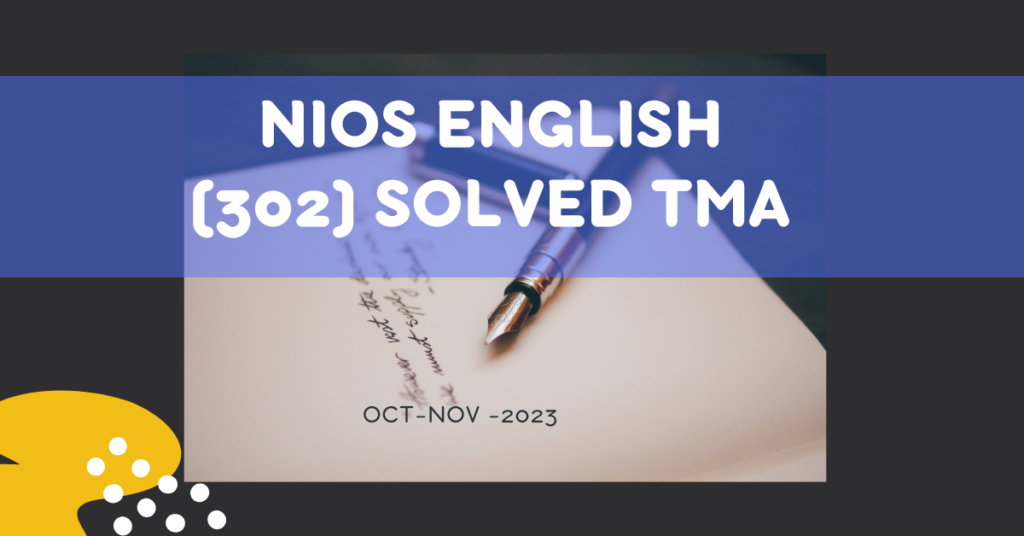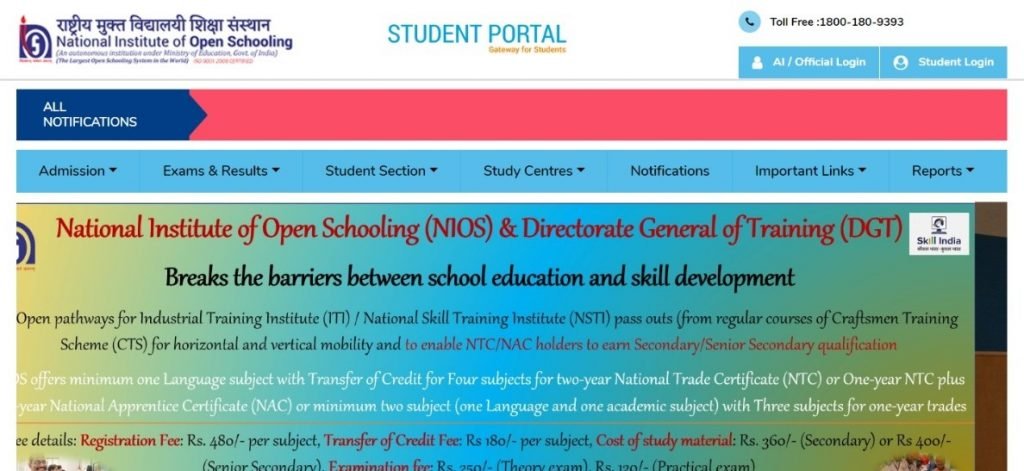National Institute of Open Schooling (NIOS): Complete answers of NIOS Senior Secondary (class 12) Home science (321) Tutor Marked Assignment. All NIOS Solved assignments (TMA) of class 12th are free. Also Solved English (302) Tutor Marked Assignment available. Link given below.
Subject: Home Science (321)
Class : Senior Secondary.
Board: NIOS.
Session: 2020-2021
Medium: English.
Home Science (321)
Tutor Marked Assignment
Marks: 20
Table of Contents
1.Answer any one of the following question in about 40-60 words. 2
(a) The study of Home Science is an Art and Science. Explain both implications with two examples each.
Answer: Study of Home science an Art and Science :
Home science serves as Arts as well as Science. Home science not only teaches us a method of cooking for satisfying our hunger but it also teaches principles of cooking for preventing loss of nutrients and adding variety, balance, and nourishment to our diet. So the Method of cooking taught in Home science is based on science and when food is served in an attractive manner, it is Art.
Similarly in another branch of home science, we learn about textile, fibre, fabric, etc along with their properties and care. But when the same garment is stitched and decorated with embroidery then it is Arts. So we can say that Home science is a combination of Arts as well as Science.
2.Answer any one of the following questions in about 40-60 words. 2
(b) Explain two techniques by which you can increase certain vitamins and minerals in food even before cooking.
Answer: Technique to increase certain Vitamin and mineral in food before cooking:
i) Germination (Sprouting): Whole seed (grain) food such Pulse (Moong, Chana, Peas), Wheat grains is Soaked in water and allowing it to sprout is called Germination. These processes enhance the nutritive value of the food. It increases Vitamin B-complex, Vitamin C and improves the digestibility of food.
ii) Fermentation: This is another method of enhancing the nutritive value of food. It is the process by which some microorganisms are added to the food to make it soft and fluffy. It enhances Vitamin B-complex, Vitamin C and improves the digestibility of food.
3.Answer any one of the following question in about 40-60 words. 2
(b) What are sources of non-renewable energy? In which four ways you ca save energy in your home?
Answer: Non Renewable energy: These are those sources of energy that cannot be replaced or renewed after it is has been exhausted.
Sources of Non-Renewable energy are: Fossils fuel, Nuclear fuel, Wood, etc
Four ways to save energy at home:
a) Switching off light/fan when going out.
b) Use of Energy efficient LED bulbs, refrigerators, etc.
c) Keeping light and fixture cleaned.
d) Use your washing machine at proper loads.
4. Answer any one of the following questions in about 100 to 150 words. 4
(b) Identify four causes of child labour and juvenile delinquency in our society. Suggest four ways to tackle the condition at the social and national level.
Answer: Causes of Juvenile Delinquency:
Poverty: It is the main cause of Juvenile Delinquency. Poor children do not have adequate facilities and comforts of life. They find stealing and robbery an easy means to get the facilities. So the young people indulge in thefts, robbery, etc
Bad Company: young people pick up activities like stealing, telling lies, breaking window panes, etc., in order to influence the leaders of their group.Violence in Media: violence in films and books depicts the delinquent as a strong character. The young boys who watch these acts identify with these characters and try to imitate their behavior.
Fight among parents: When parents quarrel with each other their voices are raised. Children do not understand these fights and get scared. The fight brings a feeling of insecurity and disappointment in them. They start indulging in crime.
Ways to tackle Juvenile Delinquency:
a) Parents must spend time with their children and discuss their problems. Encourage them to develop good habits and sound values. b) Vocation training: Various Vocational courses and training can be organised. This will enable them to stand on their feet.
c)Poverty removal programme: Certain financial support at the nominal rate of interest for starting a vocation.
5.Answer any one of the following questions in about 100 to 150 words. 4
(a) You have Rs 10,000/- and you want to start your business of cloth dyeing from home. Answer the following in this regard.
(i) On which cloth or garment will you start your work? Why?
(ii) Where do you want to deposit your income? Why?
(iii) Make a spending plan for your business.
(iv) Design the management steps of your business.
Answer: (i) Cloth dyeing business can be started for Dupatta, Ladies’ suits, etc. Low investment and easy availability of raw market are the reason from starting cloth dyeing business with Dupatta and Ladies’ suits
ii) I will deposit my income earned by the business in a bank.
Advantages of saving money in a bank:
Money is safe in the Bank.
We will get interest on my deposited money.
I can withdraw money from the bank when ever need it.
iii) Spending plan for the business:
| Items (Description) | Amount |
|---|---|
| Raw Materials | Rs 2000 |
| Labour | Rs 2500 |
| Rent | Rs 1500 |
| Transportation | Rs 500 |
| Electricity | Rs 500 |
| Miscellaneous | Rs 500 |
| Cash in Hand | Rs 2500 |
| Total | Rs 10000 |
iv) Management process for business:
Planning: The first step in management process is planning. All activities that is to be taken are sequentially listed. Planning regarding procurement of finance, raw material, Hiring of labour, and market for selling
product are made.
Organizing: All the resource for starting a business are collected finance, Raw materials and labour are organised. Responsibility and authority are fixed.
Controlling: After starting actual work and Putting plan into action, we have to see wether work is being
going on as per plan or not. Course correction steps are taken If work is not going as per plan.
6.Prepare any one project out of the given below: 6
(b)Search by own study or through Internet and write any five tips for the following and demonstrate one.
(i) Organization of kitchen.
(ii) Cleaning of bathroom.
(iii) Good and bad effects of microwave.
(iv) Freezing of vegetables at home.
(v) Enhancing the self confidence of school children.
(vi) Tracing a design for embroidery.
Answer:
i) Organising Kitchen: The kitchen should be organized in a manner that it has functional space, clear counter as much as it can be possible.
The first step is to keep frequently used items at the eye level The items that are rarely used are kept further away or up higher. Keeping Spices salt etc in a clear container and place at eye level in cabinet.
Plates, bowls, basic glassware, cups, serve ware, cutlery is kept closer to the dishwasher if possible.
iii) Good and bad effects of microwave
The good effects of the microwave
a)Take less time to heat food
b)Flavor and Nutrition are retained in the food.
c)Utensil used in the microwave is easy to clean.
d)Less energy consumption. Automatics on/off.
The Bad effects of microwave:
a) Uneven cooking causes food poisoning.
b) No option for deep frying.
c) Vegetables cooked in the microwave lose some of it nutrient.
d) Plastic food wrapper creates carcinogens in food.
(iv) Freezing:
Freezing fruits and vegetables in season can be of great benefit as they can be available when they are not in season.
Methods of Freezing: Select fresh, tender vegetables and shell them. Take sufficient water to completely immerse the Vegetables. Add 10 gms of salt for every 1 liter of water and boil. Add Vegetables to the boiling water and leave for 2 minutes. Drain and cool immediately. Pack in small polythene bags, remove air by pressing and seal the bags. This is done so that no micro-organisms remain in the packet. Place the packets in the freezer. A temperature of 180C is recommended for the storage of frozen foods.
(v) Enhancing the self-confidence of school children.
a) Encourage children to try new things.
b)Positive self-esteem should be nurtured in the children. Teach them to trust themselves.
b) Help children to find their passion.
c) Don’t get upset about children’s mistakes. Help them to learn from the mistake.
(vi) Tracing a design for embroidery.
Using Carbon Paper:
(i) Place the fabric on a smooth, hard surface and anchor it with a tape.
(ii) Carefully place a carbon paper, carbon side down, between the fabric and the design, secure it with a tape.
(iii) Place the design in the correct position and tape it in place.
(iv) Trace the design with a dry ball-point pen. Use enough pressure to transfer clearly.
(v) Use white or yellow carbon on dark coloured fabric and blue carbon on light coloured or white fabric.
Using a glass plate and light:
(i) Place a piece of plain glass sheet on the arm rests of a chair. Place a lighted
bulb under the glass.
(ii) Transfer the design on a thin paper.
(iii) Now put the paper on the glass, lay the fabric on top of the paper and outline
directly on the fabric with a hard pencil.
Also Read:
FREE NIOS English (302) Solved TMA 2020-2021.
FREE NIOS Business Studies (319) TMA 2020-2021
Please Share:







Home science 321 answers 2020-21